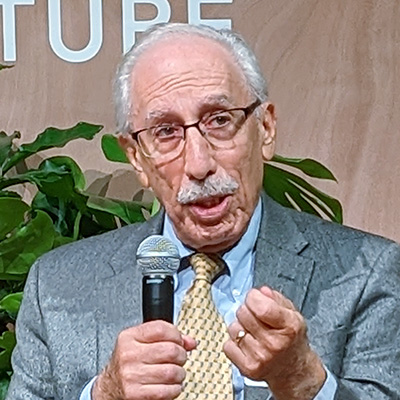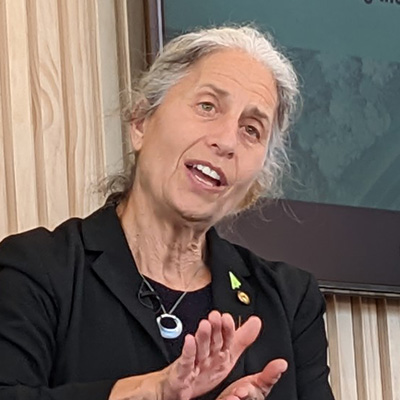
WASHINGTON — Decarbonizing the hardest-to-decarbonize industries will likely involve some failures, said Geraldine Richmond, the Department of Energy’s undersecretary for science and innovation.
“We have to accept that some things are going to fail, that things are not going to go out as fast as we want. But that’s because we’re moving hard and we’re trying to do the best we can,” Richmond said at Resources for the Future’s Net Zero Economy Summit on Thursday. “But if you don’t take those risks, you’re not going to get anywhere. … So, we’re just going to have to suck it up and keep going. It can’t stop us.”
 Geraldine Richmond, DOE | © RTO Insider LLC
Geraldine Richmond, DOE | © RTO Insider LLCTackling industrial decarbonization is now widely recognized as essential to U.S. and global efforts to cut greenhouse gas emissions to net zero by 2050, and it has become a regular part of the agenda for any clean energy conference. At RFF’s event, discussions ranged from steel and cement to international aviation.
During an industrial decarbonization panel, both Richmond and Alan Krupnick, industry and fuels program director at RFF, argued for the value of the lessons learned from failure. Krupnick pointed to the Petra Nova carbon capture project, a much hailed project at a coal plant in Texas, which received about $190 million in DOE funds and closed down in 2020.
Referring to funding for carbon capture in both the Infrastructure Investment and Jobs Act and the Inflation Reduction Act, Krupnick said, “Even failures can provide us learnings. … What we have to do … going forward, we have to expect failure. We have to learn from it and then move forward.”
The DOE’s Earthshots initiative is aimed at solving some of the core challenges of industrial decarbonization, such as the Hydrogen Shot’s goal of cutting the price of green hydrogen to $1/kg within the decade and the Industrial Heat Shot’s effort to reduce emissions from industrial heat processes by 85% by 2035.
The goal, Richmond said, is “to take everything from a discovery science all the way to the applied science and demonstration, so they can pass them off to deployment.”
Each of the shots has a goal, she said, that has “in mind a cost, has in mind efficiency, has in mind stumbling blocks that we have to get over in order to make progress. In the past the Department of Energy hasn’t been as coordinated as it is right now with regards connecting the discovery science to the applied science. … Now we’ve gotten tight; we’re rolling so that we can make sure that the discoveries get all the way to deployment.”
‘A New DOE’
With the midterm elections looming, Krupnick said the DOE is creating challenges of its own in its effort to get the IIJA and IRA funds out the door as quickly as possible “before the possible change in control of Congress and before a possible change in the presidency to the Republicans.”
 Alan Krupnick, RFF | © RTO Insider LLC
Alan Krupnick, RFF | © RTO Insider LLCReferring to the DOE’s recent funding announcement for hydrogen hubs, he said, “we’ve taken the discipline of the market in making decisions across technologies, and we’ve moved it basically to DOE, [which] has to pick winners out of let’s say there might be 30 or 25 hydrogen hub proposals, and only a fraction of that will get go/no-go decisions for the next round. … It puts a lot of responsibility on DOE to make correct choices.” (See DOE Opens Solicitation for $7B in Hydrogen Hubs Funding.)
Still another factor in the funding process is President Biden’s Justice 40 initiative, which requires that 40% of the benefits from federal funding go to low-income and disadvantaged communities.
“It’s important for us to make sure that we are putting these facilities in places that have had their factories shut down,” Richmond said. “So, we’re really paying a lot of attention to that, whether it means we’re thinking about putting a nuclear plant where there was a coal mine so that it provides jobs for workers in that place.
“It’s a new DOE,” she said. All basic science programs at labs and universities that apply for funding “must put [in] a plan on how you’re going to be inclusive in your operation. … That means the students that you’re going to train for the future, those that have been marginalized, those that have been left out in the past because they couldn’t afford to, for example, go to graduate school, you have to show what you are going to do to get those students into the workforce.”
Cement
Sean O’Neill, senior vice president of government affairs for the Portland Cement Association, an industry trade group, talked up his organization’s roadmap to make the cement and concrete industry net zero by 2050. The processes involved in making cement require high temperatures, generally provided by coal and carbon capture utilization and storage which “is a critical part” of the PCA’s roadmap, O’Neill said. “We cannot reach our goals without CCUS,” he said, while also noting that the industry is experimenting with other, lower-carbon fuels, such as biomass and natural gas.
 Sean O’Neill, Portland Cement Association | © RTO Insider LLC
Sean O’Neill, Portland Cement Association | © RTO Insider LLCBut the one thing O’Neill says his members are not talking about is cutting back on production, particularly in light of the need for cement and concrete for infrastructure projects funded by the IIJA. “It’s not a conversation we’re having,” he said. “The conversation that we’re having is how can we continue to meet infrastructure needs in this country, in the world, while also looking to decarbonize the process.”
One example, he said, is Portland limestone cement, which has a higher limestone content and lower carbon intensity than traditional cements. But the industry is still struggling to get it included in project specifications, O’Neill said. Instead of “prescriptive specifications” for big infrastructure projects, he called for “performance-based specifications … [that] will drive the market for our low-carbon cement and concrete.” (See Challenges Loom for Decarbonizing Concrete.)
Looking ahead, O’Neill said the industry is focusing on “what can we do to ensure there is a market for these materials. A lot of it has to go to standards and specifications. … At the end of the day, a contractor or owner who’s going to be constructing an asset, they want to have the confidence that the lower-carbon concrete that they’re using to build whatever they’re building will perform.”
Aviation
International aviation is notoriously hard to decarbonize “because lightweight liquid transportation fuel is pretty tough to beat when it comes to the challenge of lifting a heavy aircraft off the ground,” said Annie Petsonk, assistant secretary for aviation and international affairs at the U.S. Department of Transportation.
Even most “sustainable” fuels are carbon-based, Petsonk said during an on-stage conversation with Billy Pizer, RFF’s vice president of research and policy. “They, when burned in the engine of the aircraft, emit carbon dioxide. … But what sustainable aviation fuels are better for the environment is on a lifecycle basis from the time that your feedstock was produced to transporting the fuel to the airfield.”
Developing standards for that analysis took the Carbon Offsetting and Reduction Scheme for International Aviation (CORSIA), an international body, seven years, she said.
 Annie Petsonk, DOT | © RTO Insider LLC
Annie Petsonk, DOT | © RTO Insider LLCAnother longstanding challenge has been how to allocate emissions from international flights. “If the plane is taking off in one country and landing in a different country, whose emissions are they — the emissions of the country of departure, the country of arrival? The [nationality] of the aircraft or the airline … may be different. How about the people on the plane?”
Earlier this month, the International Civil Aviation Organization, an UN agency, adopted a long-term “aspirational goal” of net-zero emissions for the industry by 2050, “with the [provision] that each country implement it in its own way,” Petsonk said. At the same meeting, CORSIA also set an emissions reduction baseline for international aviation of 85% of 2019 emissions beginning in 2024.
“What this means is that, for the first time, global aviation has both a near- and mid-term goal from now to 2035 … and a long-term goal, which is a really important signal to send, the 2050 goal, since aviation is a long capital stock industry,” she said. “It takes many years to develop [a plane], test it, fly it and [put] it into production and keep it in production for decades.”
The international lifecycle standards are being used as a baseline for the IRA’s tax credits for sustainable aviation fuels, Petsonk said. The tax credit starts at $1.25 per gallon “if the fuel is at least 50% better than fossil fuel on a lifecycle basis.”
It goes up a penny per gallon “for every percentage point improvement in lifecycle [emissions] up to completely carbon neutral,” she said. “We’re already seeing a terrific market response to this. … We’re hearing a lot from investors,” who already want the tax credit extended beyond the IRA’s 10 years, she said.

